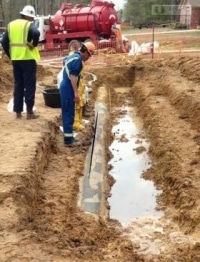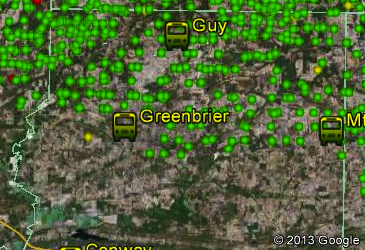There are few better examples of a “sacrifice zone” for ExxonMobil and the fossil fuel industry at-large than Faulkner County, Arkansas and the counties surrounding it.
Six weeks have passed since a 22-foot gash in ExxonMobil’s Pegasus tar sands Pipeline spilled over 500,000 gallons of heavy crude into the quaint neighborhood of Mayflower, AR, a township with a population of roughly 2,300 people. The air remains hazardous to breathe in, it emits a putrid strench, and the water in Lake Conway is still rife with tar sands crude.
These facts are well known.
Less known is the fact that Faulkner County – within which Mayflower sits – is a major “sacrifice zone” for ExxonMobil not only for its pipeline infrastructure, but also for the controversial hydraulic fracturing (“fracking”) process. The Fayetteville Shale basin sits underneath Faulkner County.
ExxonMobil purchased XTO Energy for $41 billion in Dec. 2009 as a wholly-owned subsidiary. XTO owns 704,000 acres of land in 15 counties in Arkansas. Among them: Faulkner.
“Private Empire” ExxonMobil is now the defendant in a class action lawsuit filed by the citizens of Mayflower claiming damages caused in their community by the ruptured Pegasus Pipeline. ExxonMobil’s XTO subsidiary was also the subject of a class action lawsuit concerning damages caused by fracking in May 2011 and another regarding fracking waste injection wells in Oct. 2012.
This isn’t the naturalist novelist William Faulkner’s Faulkner County, that’s for certain.
A Fracking Class-Action Lawsuit
In May 2011, James and Mindy Tucker filed a class action lawsuit in the U.S. District Court for the Eastern District of Arkansas. Among the defendants was XTO.
“This action is being brought against the Defendants for the creation of a noxious and harmful nuissance, contamination, trespass and diminution of property values that the Gas Wells have caused and continue to cause,” explained the complaint. “This action seeks…injunctive relief in the form of monitoring of air quality, soil quality and water quality on Plaintiffs’ property…[and] to have their property monitored for the harmful effects of the Gas Wells owned and operated by the Defendants.”
Like many others, those living in the vicinity of the industry’s fracking wells saw their drinking water become contaminated and lost forever for consumption purposes. The complaint says the Plaintiffs noticed their water began to smell like “cotton poison.”
“After the water had acquired this smell, the Plaintiffs had to discontinue use of their water for normal household uses,” reads the complaint.
A subsequent well water test revealed massive levels of alpha-Methylstyrene, a flammable and poisonous chemical and a known component found within fracking fluid.
“Each of these suits asks for establishment of a fund for monitoring environmental contamination, a medical monitoring fund, $1 million in compensatory damages, and $5 million in punitive damages,” explains a press release from the law firm that brought the suit.
Epicenter of Fracking Wastewater Injection Earthquakes
About a year and a half after the first class action lawsuit, Arkansas citizens brought forward a second suit in Oct. 2012, the first ever pertaining to waste injection wells. Five of the nine plaintiffs live in Faulkner County.
“This action is being brought against the Defendants for trespass, theft of property, and unjust enrichment that the oilfield waste wells have caused and continue to cause,” the complaint for the class-action lawsuit reads.
XTO owns the 7,035-foot Ferguson waste injection well in nearby Independence County, which it created in 2010. The class bringing the suit described the public notice XTO presented announcing its Ferguson well’s entrance into the County as “misleading.”
“The notice specifies the latitude and longitude of the injection well itself,” explains the complaint. “It does not reveal that the fluid, once injected at that specific location, would flow away from the injection site and onto the property of others in the area.”
At the time of the complaint, XTO had injected 84 million gallons of fracking waste into the Ferguson well.
“They are seeking $2 million in compensatory damages and $15 million in punitive damages for each plaintiff, plus an order requiring the defendants’ disposal wells to be monitored for migration of waste fluids,” the Log Cabin Democrat wrote.
Dozens of fracking waste injection-caused earthquakes have occured in Faulkner County, with 12 small quakes in a 5-day period back in Oct. 2010, another ten quakes in a single day in Nov. 2010 and a sizeable 4.7 magnitude quake shaking things up in Feb. 2011.
Due to the regular seismic activity, the Arkansas Oil and Gas Commission ordered two wastewater injection corporations to shut down their wells in April 2011.
Life Unconventionally Turned Upside Down
Those living in Faulkner County find themselves caught in the crosshairs of the industry in the age of “extreme energy.” That is, unconventional fossil fuel extraction and transportation has become the norm and the hazards of the North American energy boom are being felt by these citizens first-hand.
“Whether it be to inject toxins under our communities or to have toxins rupture onto the surface it is very clear that we have some work to do to ensure the safety of our residents in the midst of all this industry activity,” April Lane, the president of the University of Central Arkansas Environmental Alliance told DeSmogBlog in an interview. “We are dealing with a major public health issue and we must as a state and community really begin to work together and address these problems for the benefit of all of those who have been and are continuing to be impacted.”
Image Credit: ArkansasFracking.org, Faulkner County’s fracking wells
Photo Credit: Duncan Firm
Subscribe to our newsletter
Stay up to date with DeSmog news and alerts







